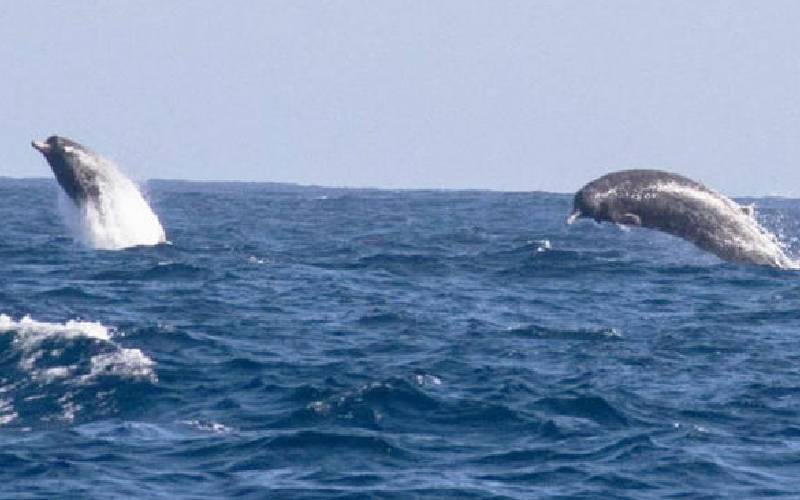
Humpback whales around the Indian Ocean waters at the Coast. [File,Standard]
As the whale watching season comes to an end, those expecting top see the big creatures at the coast are a disappointed lot. Humpback whale migration has become a sensation among local and international tourists, specifically the areas of Watamu and Malindi between the months of July and September.
Female humpback whales travel to Kenyan waters to take care of their calves. Despite reports on the on-shore sightings of the migrating and breeding whales in 2020, this migration season has disappointed in numbers.
“The numbers have been very low and most of the information we’ve been getting is the whales have been off-shore and not in-shore compared to what we saw last year,” says Michael Mwang’ombe, the Kenya Marine Mammal Project Coordinator with Watamu Marine Association.
READ MORE
Sacrificing human needs on the altar of conservation is wrong
Patient dies by suicide at Coast General Hospital
“In 2020, we did 27 trips and sighted 81 humpback whales. However, this year, we are on our 9th trip and have only sighted five humpback whales. We have compared the information with the partners we have been working with and the reports have been the same, which has caused us to start doing research to see what has changed between 2020 and now,” he added.
Reports by the Kenya Marine Mammal Network show that humpback whales were first seen in Kenya by fishermen 30 years ago, in single numbers during the migration season.
The numbers have steadily increased over the decades due to the ban on whale hunting since the 1960’s. From 2011, Kenya and the International Whaling Commission recognised the importance of humpback whales, both ecological and economical, with the rise in the whale watching industry globally.
Mwang’ombe says it’s too early to give a comprehensive report on what has changed in the last one year that has affected the migration of whales to the Kenyan Coast, but adds that they have made one significant observation.
“One interesting thing I’ve seen is fishermen reporting that they have seen the whales, but they have seen all of them off-shore. Last year, we had a lot of mothers and calves and the mothers would come inshore to take care of the calves. But this year, the reported sightings have been of a single whale or two male adult whales.”
He said since 2014, they’ve always seen whales between July and August, but in August this year they only had two sighting from land.
Since the Kenya Marine Mammal Network was established in May 2011 until December 2019, 1,511 sightings have been reported from 105 different collaborators. The Kenya Marine Mammal Network data that was published in Internationals Whaling Commission Technical Report 2020 showed that there were 1,406 records of 24 different species of whales and dolphins in Kenya.
The top three reported species between 2011 and 2019 are the Indo-Pacific bottlenose dolphin with 657 reports, the Humpback Whale with 644 reports and the Indo Pacific Humpback dolphin with 58 reports. In 2014, there were 24 humpback whale sightings, 35 in 2015, 66 in 2016, 71 in 2017, 197 in 2018. There was a sharp decline in 2019 with only 35 reports of humpback whale sighting.
The Kenya Marine Mammal Network 2020 newsletter reported that the International Whaling Commission had in their ‘Whale Watching Hand-book 2018’, highlighted Kenya as a whale watching case study for the implementation of good whale watching protocols and an alternative to unsustainable inshore fishing activities.
vwandera@standardmedia.co.ke

